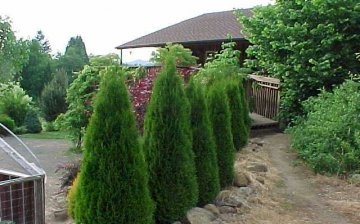Thuja in the photo for a landscape design project
Landscaping has long won special attention among private house owners. Beautifully decorated gardens, flower beds and just courtyards are considered almost a sign of good taste, what can we say about the beauty of the decorated squares.
For decorating courtyards in a conservative style, thuja are very often used - evergreen trees, which are very often referred to as a type of spruce. In fact, thuja belong to the cypress family. Thuja in the photo look more than attractive, and this plant is not whimsical at all in care, which is why it is so often used to decorate land near the house. Thuja takes root well on a wide variety of soils, but the growth rate just depends on the fertility of the soil itself. Lush and beautiful crowns develop on soils with an admixture of sand and peat.
Thuja takes root well in well-lit areas, with sufficient humidity, as well as in a place protected from drafts and even simple winds. Some types of thuja take root well in partial shade.
During the period of active growth, as well as after planting a tree or a thuja shrub, it must be thoroughly moistened, sometimes even spraying the crown is required, but it is best to do this at night. The soil should be loosened regularly, and mulching of the soil is also recommended.
The thuja in the photo very often amazes with its decorative and very beautiful forms - pyramids, cones, balls and even spirals. It lends itself well to pruning and crown shaping. The plant can be a tree, or it can be a shrub - it depends on the type of plant.







I like thuja only not at home - they seem, for me personally, to be somehow alien, distant and unapproachable.
In my opinion, one of the best trees to beat the landscape of your site. Unpretentious, in skillful hands (if properly cut), can take quite interesting and bizarre forms. Great for planting along a fence.